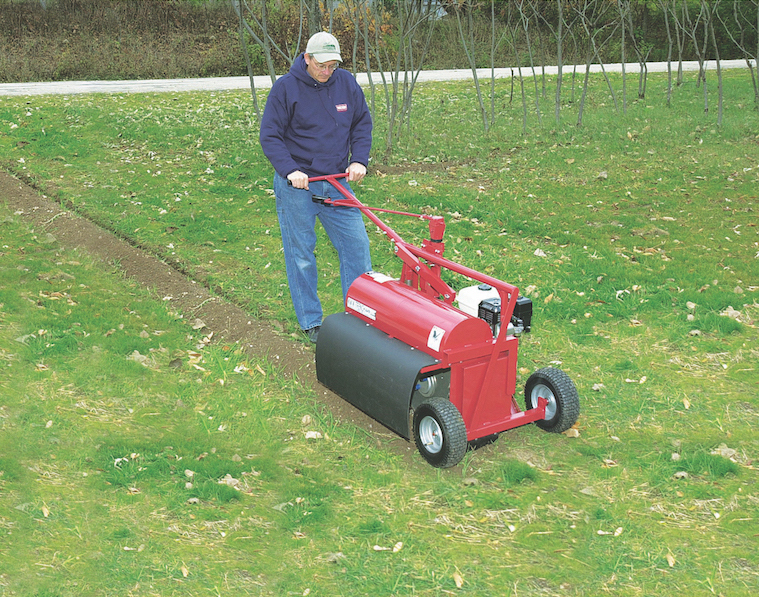Work Smarter, Not Harder

By Mike Hale
Does a contractor really need to use a trencher to dig for irrigation, plumbing and drainage lines? Well, technically no, but it sure does make it fast and easy, especially if you choose the right type of trencher for the job.
Chain-driven models are typically larger and can’t reach narrow widths and shallow depths, making them overkill in these applications, not to mention they can be cumbersome to maneuver. Fortunately there are smaller, more easy to use (and budget-friendly) models that are perfect for these types of projects.
Mini trenchers, also called slit trenchers, are specifically designed to dig the narrowest and shallowest trenches, and there are two types of models that can do it. One features a rotor and the other has a cutter wheel with carbide-tipped teeth.
The powerful-yet-compact machines are able to dig clean, narrow trenches from ½ to 4 inches wide, and they feature adjustable cutting depths to 13 inches. The small trench size minimizes the impact on landscapes and also generates less backfill. Some models even direct the spoil to just one side, making backfill 50 percent faster than those that kick it out to both sides. In addition, once backfill is complete, the amount of cupping that occurs as dirt settles is minimal.
And, despite their small size, the performance of these trenchers is exceptional. With engines that range from 5.5 to 8 horsepower, a mini trencher can reach up to 800 rpms and, depending on soil conditions, can cut 30 feet of trench in a minute. That’s 20 percent faster than chain-driven units, and the faster operation means contractors can do more in less time.
The carbide-tipped teeth in models with a cutter wheel are durable and long lasting, and they can power through hard soils, tree roots and even driveway asphalt. The only material not suitable for these types of trenchers is rocky soil. The trencher would kick the rocks, resulting in a potential hazard to the operator or any bystanders.
Saving time is great, but what really makes these mini trenchers a must have is that they are ergonomic and easy to use. Unlike trenchers that need to be pulled backward, some slit trenchers can be pushed forward. This design, combined with the units’ compact size, allows operators to easily maneuver into tight spaces near structures and trees that larger trenchers simply can’t access.
Push-forward slit trenchers are, by design, safer than those that require backward pulling because they give operators a clear view of what lies ahead. In contrast, the operator of a backward-pulling mini trencher doesn’t have that clear view, and he is also is at risk if he trips and pulls the trencher toward himself. However, a clutch lever found on some backward pulled units enhances safety by shutting the engine down if the operator lets go. Many units also feature shrouding over the cutter or rotor wheel to keep debris contained and operators safe.
In addition to enhanced safety, low maintenance is another key benefit of mini trenchers. Some models feature a triple V-belt system that maintains positive traction if the trencher encounters an obstruction. This reduces wear on belts so they can be replaced less frequently than the belts on single-belt trenchers. A slip clutch built into the hub of the cutter wheels on some models kills the motor if the trencher hits something, preventing wear to the drive train and damage to cutting teeth. Finally, if cutting teeth or rotors need to be replaced, it’s simple and less costly to do compared to chain trenchers.
Less maintenance after the trench is dug also saves contractors time. Unlike track-driven models that cause damage to turf, mini trenchers are equipped with pneumatic tires to minimize damage to delicate surfaces, which means less time and money spent on repairs. The pneumatic tires and relatively small size of the machines also make them easier to load and unload. Some manufacturers also offer specially designed trailers for transporting from one job to the next.
Contractors can use mini trenchers to dig trenches for everything from irrigation systems to plumbing, drainage lines to low-voltage wiring and silt to electronic dog fencing. They also are great for straight-line landscape edging and other not-so-typical applications such as root pruning.
Mini trenchers make these types of projects go smoother, faster and safer, which ultimately saves contractors time and money. And that’s the definition of working smarter, not harder.
Mike Hale is sales manager, Little Beaver Inc. In 1974, Hale started his career in the fencing industry, and in 1996 he began working at Little Beaver Inc., where he continues to offer expertise on fencing and hole digging equipment as the sales manager. He can be reached at mikeh@littlebeaver.com.


